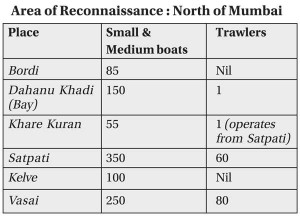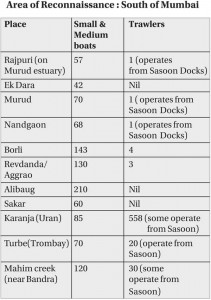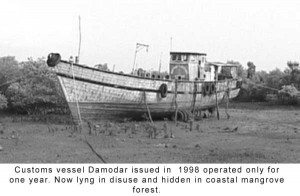Revamping Coastal Security Apparatus: Considering the inadequate coastal security infrastructure along the vast and porous Indian coastline the issues relating to registration of boats, transponders and bio-metric identity cards for fishermen, port workers and others associated with maritime activities assume tremendous urgency. With maritime terrorism actually becoming a reality, security agencies have observed that there are several fishing harbours in India that are operational within port limits. Clearly these fishing harbours could be misused by maritime terrorists and, therefore, a clear plan of action must be enunciated to relocate such fishing harbours, taking due cognizance of the livelihood issues of the fishermen and ensuring that they are not adversely affected.
Also read: Gaps in Maritime Security-I
 While these are issues that the Indian government is keen to address in the most effective and time bound manner, much will be achieved if a ‘mission mode’ work ethic is infused to ensure that the Indian national security establishment is in a position to deter the most sophisticated maritime terrorist attack of the future.
While these are issues that the Indian government is keen to address in the most effective and time bound manner, much will be achieved if a ‘mission mode’ work ethic is infused to ensure that the Indian national security establishment is in a position to deter the most sophisticated maritime terrorist attack of the future.
A hallmark ground survey carried out by this author and his team of investigators three years ago is still relevant because nothing has changed on the ground. In addition to the status quo, what the rough survey does reveal is the massive task at hand when it comes to revamping coastal security. The survey randomly selected certain fishing harbours along the Konkan coast in Western India.
Most of these places are small centres of fishing, barring Dahanu Khadi, Satpati, and Vasai where trawlers are available. Of these Dhanu Khadi is the smallest, rural place, where people are a little more simplistic, and not as suspicious and street smart as the people in Vasai and Satpati.
Other places like Bordi, Khare Kuran, Kelve, do not have trawlers, they have smaller, diesel engine boats, which use more traditional floating net methods of catching fish. Their boats are not that powerful, but these also go outside Indian territorial waters.
(There are many more fishing villages along this section of the coast but the above fishing centres were visited for the purpose of the survey)
Murud – Janjira (Estuary) Area
- The Murud- Janjira estuary is a deep estuary (at least 10 km deep) with several villages around it. Still it is quite isolated with long stretches where one could not see a soul for miles. Fishing societies affirm that they are rarely checked. Patrolling rarely happens along this stretch.
- The local Customs ’speed boat’ is actually a normal medium boat commissioned in 1998, but rotting in a mangrove near Agardanada (close to the mouth of the estuary).
Revdanda, Kashid, Nandgaon
- From Nandgaon, to Kasid, the population along the seafront is extremely sparse. The beaches are extremely rocky and the few fishing villages are in small estuaries / bays.
With well armed Somali pirates wreaking havoc on shipping lanes from the Indian Ocean to the Gulf of Aden between Somalia and Yemen, Al Qaeda and its associate terror groups could easily outsource maritime terrorism to mercenary pirate groups.
- Revdanda is a big fishing center along the Kundalika river. There are several fishing villages along the coast and the mouth of the river.
- The Customs has a major office with the Superintendent of Customs stationed there.
- Revdanada is also the base all patrol boats of the Raigad district police. In 2004 three new Patrol boats were purchased for patrolling the coastal waters. But instead of placing them at three different places and evenly distributing jurisdiction between the three all the boast are based in Revdanda. But with no dedicated staff these boats have become inoperable and are rotting in the mangroves.
- There is a private (commercial jetty) in the middle of the river Kundalika, owned by the Vikram Ispat Co. (Grasim Group). Large ships carrying iron ore dock there and unload there consignment, which is then transported by conveyor belt to the plant a kilometer upstream.
Alibaug – Sakar Area
- The Alibaug Sakar area is more active in terms of number of boats. The beaches here are very flat, but most boats here are small 2 / 3 cylinder engine boats.
- The two Customs offices in this area are literally non-functional. Two years ago both were locked and in dilapidated condition. Fishermen say that the Customs staff work half a day and then disappear. They hardly check the fishing cargo unloaded at the Alibaug-Sakar stretch. The police presence in this entire region from Murud to Alibaug is very minimal.
Karanja (Uran)
- Uran is just across Thane creek from Colaba. Uran is also where, JNPT (Jawahar Lal Nehru Port Trust) is situated. And the Oil/ Gas jetties of ONGC are in Nahva-Sheva.
- Karanja is the biggest fishing centre in all of Maharashtra. A lot of the trawlers operate out of the Sasoon docks in Mumbai. There is little local police presence in Karanja itself.
- There is a large Customs office in Mora (6 km from Karanja), which has recently switched to a computerized database management system. As a result all boats which operate out of this area now have numbers like (F/MOR/04/xx) earlier they were just KRJ (meaning the boat is registered in Karanja) or URN(meaning the boat is registered in Uran)
- There is a small sub-inlet off Thane creek, called Panvel creek (along Vashi/ Navi Mumbai). Here the Central Railway is building a new line and a bridge. Huge barges carrying sand sail in and offload in the area. The Ambuja Group has a jetty on Panvel creek and there is one Customs patrol vessel stationed here.
Trombay Area: (Turbhe)
- Trombay is where some extremely important Defence/ Government institutions are located (right on the coast), among these are the:
– The Bhaba Atomic Research Centre (BARC)
– The Trombay Refinery
– The Rashtriya Chemicals and Fertilisers (RCF)







It seems, that the Mumbai bomb blasts in 1992, happened when Dawood Ibrahim was making his business interests legitimate in Mumbai, as liberalization was happening. Smuggling was becoming less of a crime, due to easing of restrictions. Before 26/11, there was no reason for anyone to believe that any militant group would have an interest in India, for subversion.
What the U. S. observed, was that groups were attacking U. S. ships and installations, and were claiming to be Al Qaeda. There was no seeming communication between Al Qaeda and these people. The conclusion was, that any group or individual was attacking U. S. interests and mentioning that they belonged to Al Qaeda. Apparently, when President George W. Bush declared the war on terror, he had this state of affairs in mind.
There was not enhanced need to patrol the coast of Mumbai, before 1992, but less of it. 26/11 was not supposed to have been even to imagination. It seems, small groups of people with a capability not available before, can do any mayhem. Pakistan had occurrences of bomb blasts carried out randomly in that nation. There are reports of training camps of militants in Pakistan, but people can learn to shoot in firing ranges, can be physically fit in training processes, and can even learn about almost anything that they would want to. It could seem, that 26/11 was such a group of people. No militant group abroad had any interest in India. The term, ‘Major Iqbal’ might be a ruse of such a group. Also, Dawood Ibrahim has family living in Mumbai, today. And his associates before he went to Karachi.
India has a 3 million army for a great population number. The U. S. has a much smaller number. Since the regular army needs a certain deployment procedure that is costly, they use special forces to combat small groups. The U. S. SEAL team 6 is an elite group, but the combat that took place didn’t have exchange of fire on a great scale, when Osama was killed.